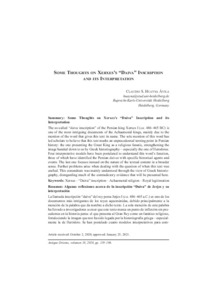Por favor, use este identificador para citar o enlazar este ítem:
https://repositorio.uca.edu.ar/handle/123456789/11722| Campo DC | Valor | Lengua/Idioma |
|---|---|---|
| dc.contributor.author | Huayna Ávila, Claudio S. | es |
| dc.date.accessioned | 2021-06-25T22:28:53Z | - |
| dc.date.available | 2021-06-25T22:28:53Z | - |
| dc.date.issued | 2020 | - |
| dc.identifier.citation | Huayna Ávila, C.S. Some thoughts on Xerxes’s “Daiva” inscription and its interpretation [en línea]. Antiguo Oriente. 2020, 18 Disponible en: https://repositorio.uca.edu.ar/handle/123456789/11722 | es |
| dc.identifier.issn | 1667-9202 | - |
| dc.identifier.uri | https://repositorio.uca.edu.ar/handle/123456789/11722 | - |
| dc.description.abstract | Abstract: The so-called “daiva inscription” of the Persian king Xerxes I (ca. 486–465 BC) is one of the most intriguing documents of the Achaemenid kings, mainly due to the mention of the word that gives this text its name. The sole mention of this word has led scholars to believe that this text marks an unprecedented turning point in Persian history: the one presenting the Great King as a religious fanatic, strengthening the image handed down to us by Greek historiography—especially the one of Herodotus. Four interpretative models have been postulated to understand this word’s function, three of which have identified the Persian daivas with specific historical agents and events. The last one focuses instead on the nature of the textual content in a broader sense. Further problems arise when dealing with the question of when this text was crafted. This conundrum was mainly understood through the view of Greek historiography, disregarding much of the contradictory evidence that will be presented here. | es |
| dc.description.abstract | Resumen: La llamada inscripción “daiva” del rey persa Jerjes I (ca. 486–465 a.C.) es uno de los documentos más intrigantes de los reyes aqueménidas, debido principalmente a la mención de la palabra que da nombre a dicho texto. La sola mención de esta palabra ha llevado a investigadores a creer que este texto marca un punto de inflexión sin precedentes en la historia persa: el que presenta al Gran Rey como un fanático religioso, fortaleciendo la imagen que nos ha sido legada por la historiografía griega—especialmente la de Heródoto. Se han postulado cuatro modelos interpretativos para comprender la función de esta palabra, tres de los cuales han identificado a los daivas persas con agentes y acontecimientos históricos específicos. El último se centra, en cambio, en la naturaleza del contenido textual en un sentido más amplio. Otros problemas surgen al tratar la cuestión de cuándo fue elaborado este texto. Este enigma se entendió principalmente a través de la visión de la historiografía griega, sin tenerse en cuenta gran parte de las pruebas contradictorias que se presentarán aquí. | es |
| dc.format | application/pdf | es |
| dc.language.iso | eng | es |
| dc.publisher | Pontificia Universidad Católica Argentina. Facultad de Ciencias Sociales. Departamento de Historia. Centro de Estudios de Historia del Antiguo Oriente | es |
| dc.rights | Acceso abierto | * |
| dc.rights.uri | http://creativecommons.org/licenses/by-nc-sa/4.0/ | * |
| dc.source | Antiguo Oriente. 2020, 18 | es |
| dc.subject | IMPERIO PERSA | es |
| dc.subject | INSCRIPCION DAIVA | es |
| dc.subject | DINASTIA AQUEMENIDA | es |
| dc.title | Some thoughts on Xerxes’s “Daiva” inscription and its interpretation | es |
| dc.title | Algunas reflexiones acerca de la inscripción “Daiva” de Jerjes y su interpretación | es |
| dc.type | Artículo | es |
| uca.disciplina | HISTORIA | es |
| uca.issnrd | 1 | es |
| uca.affiliation | Fil: Huayna Ávila, Claudio S. Ruprecht-Karls-Universität Heidelberg; Alemania | es |
| uca.version | publishedVersion | es |
| item.grantfulltext | open | - |
| item.fulltext | With Fulltext | - |
| item.languageiso639-1 | en | - |
| Aparece en las colecciones: | AO - 2020 vol. 18 | |
Ficheros en este ítem:
| Fichero | Descripción | Tamaño | Formato | |
|---|---|---|---|---|
| some-thoughts-xerxes-daiva.pdf | 332,45 kB | Adobe PDF |  Visualizar/Abrir |
Visualizaciones de página(s)
247
comprobado en 30-abr-2024
Descarga(s)
858
comprobado en 30-abr-2024
Google ScholarTM
Ver en Google Scholar
Este ítem está sujeto a una Licencia Creative Commons

